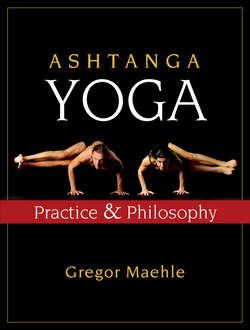Читать книгу Ashtanga Yoga - Gregor Maehle - Страница 184
На сайте Литреса книга снята с продажи.
Оглавление
Top, Utkatasana, vinyasa seven; above, vinyasa eight
Balancing on the arms develops core strength. The body must draw all forces together and work as one unit. This is an important aspect, especially necessary for those whose bodies are naturally soft and flexible. There is a tendency for students who swiftly gain flexibility to progress more and more in that direction. Flexibility, however, often accompanies low muscle tone. Low muscle tone is the ability to lengthen muscles with a relative inability to contract them. This tendency needs to be counteracted by focusing on building strength rather than more flexibility.
YOGIC CONTEXT
Asana — The Seat
In some contemporary forms of yoga the lotus and half-lotus postures are neglected. If the student practices out of ambition, and the underlying technical principles are not understood, these postures can in fact be detrimental. This is a great shame, as the hip rotations are arguably the most important yoga postures, with Siddhasana and Padmasana (lotus posture) high in their ranks. The Hatha Yoga Pradipika calls Siddhasana “the principal asana” and claims it to be “the gate to freedom.” About Padmasana it says, “It opens the path to liberation.” The Gheranda Samhita says about Siddhasana, “It leads to freedom” and about Padmasana, “It wards off all diseases.”
Shiva Samhita recommends that Siddhasana should be adopted if quick success in yoga is desired, and agrees with the Gheranda Samhita that Padmasana “protects from all diseases.” The Yoga Yajnavalkya says that, “Padmasana is esteemed by all.”
There is enough evidence to deem the hip rotations as the most important category of yoga postures, with all other postures preparing us to stay for a longer time in asanas such as Padmasana and Siddhasana.
This exercise might initially seem daunting, but a sincere effort every day will take you a long way in a year.
